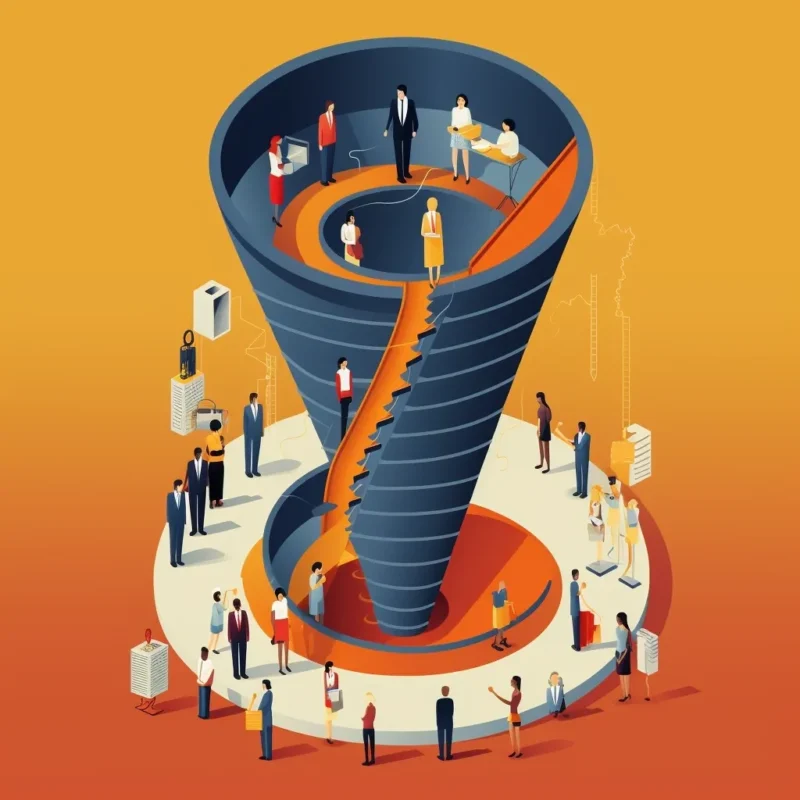If you’re in a strong romantic relationship, you know it takes time to build it.
Time to woo your partner and show your love, with the clear aim of making them fall for you in return. Such courtship should be based on the tastes and desires of the other to ensure both are happy and comfortable in the relationship.
Do you remember how you identified what makes your partner happy?
You probably did so by listening and paying close attention. Once you knew, you likely made efforts to please them, whether to see a smile or receive a hug or thank-you kiss.
This is how you cultivated the trust and love that exists today.
Falling in Love in Inbound Marketing
Just as in relationships where you focus on what pleases and satisfies your partner, digital marketing works similarly.
Your potential customers are so focused on their needs, desires, and problems that the best way to introduce them to your products and services is by giving them what they want and are looking for.
Traditional advertising is selfish as it focuses on selling. Today’s consumers are tired of being bombarded with ads unrelated to them, pressuring them to BUY.
That’s why inbound marketing emerged, focusing on attracting prospects instead of chasing them, respecting their tastes, and freedom to choose their preferred brands.
What is the Role of Copywriting in Inbound Marketing?
Now that we understand this, let’s look at the role of copywriting. Primarily, remember that copywriting involves writing persuasive commercial texts to convince your buyer persona to buy your products/services. That’s why the characteristics of this buyer persona are the main reference for guiding the writing of all your content and advertising materials.
Since you’re targeting this specific customer profile, the words you use to converse with them should also align with this profile. You should understand that nobody unfamiliar with your brand is ready to receive your offer from the get-go. To achieve this, you must implement a “conquest plan”. This plan unfolds over various phases, set by inbound marketing. It goes from the first contact you make with the user to the point where they become a loyal follower and promoter of your brand.
How to Apply Copywriting in Inbound Marketing
So, at each stage, the prospect should receive the necessary content to progress in the buying cycle and reach that point of loyalty. The content must be engaging and attractive enough to hook potential buyers, guiding them until they become your customers. That’s the role of copywriting, which is why it’s so essential in your digital marketing strategy.
Through the right words, people will remember, love, and consume your offer. After all, by taking action, prospects advance in the buying cycle, leading to the final transaction.

What Language Should You Use to Communicate with Your Buyer Persona?
Given the above, it’s essential that all your communications focus on your target, which changes its behavior throughout the sales funnel.
Copywriting for Each Stage of the Sales Funnel
The buyer persona goes through four phases to become an evangelist for your brand. Think of these as the “courting” stages a stranger undergoes to become your customer.
These stages are: DISCOVERY, CONSIDERATION, DECISION, PURCHASE, and LOYALTY.
Each stage has specific content based on respective goals.
Let’s see how to apply copywriting to each.
DISCOVERY STAGE

The goal here is to draw users to your brand, familiarize them with your offerings, and get them registered in your database.
The best way to achieve this is by providing content that matches their interests via blogs and social media. Hence, it’s essential to have these platforms.
At this stage, the buyer persona might not be aware of a problem or need. Your mission is to help them realize it.
You can achieve this through educational content centered on issues your product/service resolves, such as:
•Checklists
•Lists
•How-to articles
•Infographics
•Ebooks
•Short videos
•Webinars
•Statistics, and more.
However, given that many companies offer related online information, you’ll need to:
•Create high-quality content that outdoes existing ones.
•Make content readable and straightforward, answering queries in an engaging manner.
•Use bold, italics, and bullet points to emphasize key phrases.
•Optimize for SEO.
•Write enticing headlines to boost the CTR.
•Connect emotionally with users via storytelling and compelling data.
•Include appealing registration forms with catchy headers and call-to-action buttons leading to landing pages, in exchange for free material downloads.
Once contacts are in your database, nurture the relationship through email marketing.
CONSIDERATION STAGE
Once potential customers recognize their problem and join your subscriber list, they move to the consideration stage. Here, prospects analyze solution options to pick their best fit. Your prospects will feel like a kid at a candy store.

Thus, your goal is to become the option they identify with most, trust the most, and believe can meet their needs best. To succeed, you must present your products/services in a way that highlights your unique value proposition and the benefits they’ll get.
Content at this stage should focus on these solutions, such as:
•Guides
•Live interactions
•Podcasts
•Video tutorials
•Comparisons
•Worksheets and specialized templates
•Online conference entries, and more.
Using these contents, you’ll target your audience’s pain points, proving your expertise and readiness to help.
This ongoing communication is done through mailing, with compelling subject lines and personalized, conversational content that resonates emotionally.
This is how you foster trust with your leads.
DECISION STAGE
If a person hasn’t bought from you after consuming your content, they might have doubts, feel insecure, or find the price steep.
Through email marketing, offer strategic content to give them the push they need, such as:
•Product and provider comparisons
•Case studies
•Trial periods
•Live demos
•Testimonials
•Demonstrations
•Success stories
•FAQs
This is where you need to justify your offer’s value with solid arguments, guiding your buyer persona to the final transaction. This is similar to convincing a person to jump in a bungee rope, convincing them that it is safe.

For info products sales, consider automated email sequences based on behavior and progress, and varying sales pages to address objections.
PURCHASE STAGE
The journey through previous stages is the “courting” process, culminating in the purchase stage.
You’ve led them to a point where they’re not just excited about your offer, but also convinced that you’re the best solution to their problem.
That’s why they purchase without feeling pressured, because the information you’ve provided has “matured” them, allowing them to choose when they buy.
This effective methodology lets them feel free to decide when they’re ready

LOYALTY STAGE
The goal with your customers is not just a one-time purchase but repeated buying and staying updated with your company’s news.
That’s what we call loyalty.
The aim of your inbound marketing strategy is to achieve loyal customers who make multiple purchases and recommend your offerings to others.
To strengthen and maintain this relationship, send them:
•Surveys
•Promotions
•Newsletters
•Exclusive discounts for subscribers
•Limited collection items
•Scholarships, and more.
Also, offers should have expiration dates to create a sense of scarcity and urgency.
Pleasing your potential customer once isn’t enough. Continue to amaze them to retain their preference.
Everything you send reminds them of why they chose you, reaffirming that decision.
In post-purchase thank-you pages, present upsell offers, premium versions of your product/service, or cross-sell recommendations of complementary products/services. This maximizes your earnings, as it’s easier and cheaper to sell to someone familiar with your brand than to persuade a stranger.
Do you see why this persuasive approach is more effective than invasive advertising?
Though it might take longer, it generates qualified clients offering higher returns. The most cost-effective way to gain visibility and establish your brand’s authority is by proving your intent to assist and showcasing your capability.
This way, you’ll gain their trust and loyalty.
As discussed throughout this article, achieving this without quality content and persuasive sales texts aligned with your buyer persona would be challenging. Copywriting doesn’t just facilitate a conversation; it also stirs emotions, motivating actions to turn them into customers.
Thus, if you aim to boost conversions on your website, implement copywriting techniques in your sales funnels. This will generate more leads, loyal customers, and consequently, higher revenues.
Ready to generate leads and build your sales funnel?

